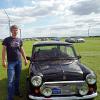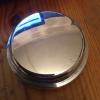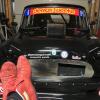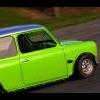Geometry
#1

Posted 19 March 2017 - 11:53 AM
Question is how do I check and adjust caster (fitted adjustable front struts) or do I need to take it somewhere who has full laser alignment set up? I read somewhere that some places don't like touching caster and will only do toe and camber if adjustable.
Finally what sort of ride height should I be looking at (12inch wheels fitted) with hi-los...
#2

Posted 19 March 2017 - 12:06 PM
You don't need to adjust the caster or camber with adjustable ride height. To adjust caster/camber you would need adjustable tie rods and bottom arms. ![]()
#3

Posted 19 March 2017 - 12:22 PM
#4

Posted 19 March 2017 - 12:49 PM
Yes. By struts I guess you mean tie rods, the bit that goes from near the bottom ball joint to the front corner of the subframe.
Caster is how much the steering axis of the wheel it tilted (forwards) from the vertical, so pulling the bottom ball joint forwards, by shortening the tie rod, increases it. There are simple gauges to measure caster and camber - by steering the wheel inwards the caster is added to the camber, steering out subtracts it. The gauge plots both so the camber can be deducted to reveal the caster.
#5

Posted 19 March 2017 - 08:02 PM
I have several friends with 4 wheel laser alignment and I've never heard any of them say castor is a bad thing to modify ! they will set your car up to a) book values, b) your choice or c) their experience
#6

Posted 19 March 2017 - 08:54 PM
So what are you talking about.
Any place with 4 wheek alignment rig will be able to set everything other than Corner weights and yes they can cause changes to the rest of the setting if way out.
#7

Posted 19 March 2017 - 09:12 PM
Had tracking done which was way out and I realise that I really should do ride height and caster first as this changes toe but it was almost undrivable as it was. I'll get it checked again later on.
Question is how do I check and adjust caster (fitted adjustable front struts) or do I need to take it somewhere who has full laser alignment set up? I read somewhere that some places don't like touching caster and will only do toe and camber if adjustable.
Finally what sort of ride height should I be looking at (12inch wheels fitted) with hi-los...
If I can suggest;-
The ride height (regrettably) does cause a change in all steering angles;- Camber, Caster and Tracking (or Toe as many of us refer to it) Angles.
I would allow the suspension to settle to some degree, then adjust the ride height I'm looking for. As a guide, for ride height, in standard form, the drive shafts on the front had a slight downward angle, with the inboard (at the gearbox) around 1/2 to 3/4" higher than the ends at the wheels. The rear is set about 1 to 1-1/2" above that.
Then to have the Camber, Caster and Toe angles set, you would be wise to go to business that specialises in doing this. It can be done at home, but is a big 'fiddle' to do so, unless you'd like to spend some time making up some gauges.
Just going back to my first line here for some background, the Mini has unequal length Upper and Lower Suspension Arms, as a result, when they move, the Camber Angle will change. This will also change the caster Angle.
It's well known (and been discussed on this forum at length!) that the Mini also has 'Bump Steer', that is, as the front suspension moves up and down, the steering (tracking or toe) angle changes. This is what it's a good idea to set the ride height - and write it down! - before having the suspension angles adjusted.
#8

Posted 19 March 2017 - 10:41 PM
The guy at garage who did the tracking thought I was talking about those and looked confused when I said I'd changed my fixed length tie rods for adjustable ones. He was obviously thinking how on earth would someone adjust toe with fixed 'tie rods'
I've only really started driving the car in the last couple of weeks although suspension was fitted back last September so hopefully has settled now so I'll check driveshaft angle as suggested
Cheers again
#9

Posted 20 March 2017 - 08:37 AM
I am reluctant to call them tie rods (hence struts) as every time I do someone mistakenly thinks I'm talking about the steering tie rods!
but those are Track rods. hence the part that attaches to the steering arm is a track rod end.
I would call things by their correct name as it makes it easier for everyone.
and yes a guy who does tracking would only think about the track rods as that is all they normally work on.
the tie bars are adjusted to bring the caster back into a suitable angle after changing the ride height and or Camber.
#10

Posted 20 March 2017 - 11:44 AM
#11

Posted 20 March 2017 - 08:55 PM
I thought I'd look up what these parts are called in the factory parts books and post those names here so we could 'standardise' on how we refer to these various suspension components.
Yeah, sounds like a good idea,,,,,,, but no.
With names like 'Rod Tie' and 'Tie Rod' referring to 2 different parts, this is way less than helpful.
I don't know if this may help or make matter worse, however, I refer to the various components as;-
Caster Bar - is the part that goes from the front of the subframe to the lower arm. Easy to remember as it sets the Caster Angle
Steering Rack Tie Rod - the threaded part that pokes out of the Steering Rack
Steering Rod End - the part the screws on to that above and is adjusted on this thread to set the Toe or Tracking.
I've also found these to be fairly Universal names or at least, broadly understood with no further description.
#12

Posted 21 March 2017 - 09:45 AM
Always been Tie Rod, Track Rod, Track Rod End and Bottom Arm to me.
But then put Track Rod into Google and the first thing that come up is this ![]() :
:
Tracking rods, more commonly known as tie rods,, are an essential part of a car's steering system. They literally "tie" the front wheels together so that they will turn together. As such, if a tie rod breaks or becomes disconnected, the driver can lose control of the vehicle, possibly causing an accident.
#13

Posted 21 March 2017 - 09:51 AM
Always been Tie Rod, Track Rod, Track Rod End and Bottom Arm to me.
But then put Track Rod into Google and the first thing that come up is this
:
Tracking rods, more commonly known as tie rods,, are an essential part of a car's steering system. They literally "tie" the front wheels together so that they will turn together. As such, if a tie rod breaks or becomes disconnected, the driver can lose control of the vehicle, possibly causing an accident.
That's what they have always been called in the U.K. BMC/Leyland parts industry.
#14

Posted 23 March 2017 - 08:26 PM
Technically, a strut is loaded in compression, a tie in tension.
so as the tie rod is in both tensile and compressive loading does this now make them "tie struts" and should they also be prefixed with Zhe for good measure ![]()
1 user(s) are reading this topic
0 members, 1 guests, 0 anonymous users



















